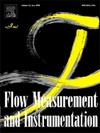Fluid-solid heat transfer analysis: In situ validation and calibration of a boiling meter using a combined experimental-numerical heat transfer approach
IF 2.3
3区 工程技术
Q2 ENGINEERING, MECHANICAL
引用次数: 0
Abstract
To study and quantify the heat transfer between wall and fluid at the transition regime between natural convection and nucleate boiling, a boiling meter, incorporating two heat fluxmeters coupled with thermocouples, along with other components, was designed and built. This paper explores the methods used to calibrate and characterize this sensor under in situ conditions. The boiling meter has been experimentally investigated in a test cell for two configurations regarding the orientation of its largest faces with gravity: one vertical and the other one horizontal. The experimental results showed inconsistencies when compared to physical expectations. To address this problem, calibration of the boiling meter, using numerical simulations is performed with the CFD software Star-CCM+. These simulations were achieved considering the heat transfer at the scale of the whole test cell. The temperature and the heat transfer rate calculated at the two surfaces at the borders of each heat fluxmeter were compared with the experimental results. It was found that one thermocouple provided temperatures closer to those calculated at the outer end of a heat fluxmeter, while the other was closer to those at the inner end. Moreover, the numerical results revealed that the temperatures and fluxes at the boiling meter-liquid interface differed from the experimental measurements. The reasons for this discrepancy were identified and analyzed. As a result, the combination of experimental and simulation approaches allowed for a deeper understanding of the heat transfer measurements and results.
流体-固体传热分析:使用实验-数值传热方法对沸点计进行原位验证和校准
为了研究和量化自然对流和核沸腾过渡状态下壁面和流体之间的传热,设计并建造了一个沸点计,该沸点计由两个热通量计和热电偶以及其他部件组成。本文探讨了在原位条件下对该传感器进行标定和表征的方法。沸腾仪在实验室中对其最大的重力面方向进行了两种构型的实验研究:一个是垂直的,另一个是水平的。实验结果显示,与物理期望相比,结果并不一致。为了解决这一问题,使用计算流体力学软件Star-CCM+对沸腾计进行了数值模拟校准。这些模拟是在整个测试单元的尺度上进行的。将每个热通量仪边界处两个表面的温度和换热率计算结果与实验结果进行了比较。研究发现,一个热电偶提供的温度更接近热通量计外端的计算温度,而另一个热电偶提供的温度更接近热通量计内端的计算温度。此外,数值结果表明,沸腾的米液界面的温度和通量与实验测量值不同。找出并分析了造成这种差异的原因。因此,实验和模拟方法的结合允许对传热测量和结果有更深的理解。
本文章由计算机程序翻译,如有差异,请以英文原文为准。
求助全文
约1分钟内获得全文
求助全文
来源期刊

Flow Measurement and Instrumentation
工程技术-工程:机械
CiteScore
4.30
自引率
13.60%
发文量
123
审稿时长
6 months
期刊介绍:
Flow Measurement and Instrumentation is dedicated to disseminating the latest research results on all aspects of flow measurement, in both closed conduits and open channels. The design of flow measurement systems involves a wide variety of multidisciplinary activities including modelling the flow sensor, the fluid flow and the sensor/fluid interactions through the use of computation techniques; the development of advanced transducer systems and their associated signal processing and the laboratory and field assessment of the overall system under ideal and disturbed conditions.
FMI is the essential forum for critical information exchange, and contributions are particularly encouraged in the following areas of interest:
Modelling: the application of mathematical and computational modelling to the interaction of fluid dynamics with flowmeters, including flowmeter behaviour, improved flowmeter design and installation problems. Application of CAD/CAE techniques to flowmeter modelling are eligible.
Design and development: the detailed design of the flowmeter head and/or signal processing aspects of novel flowmeters. Emphasis is given to papers identifying new sensor configurations, multisensor flow measurement systems, non-intrusive flow metering techniques and the application of microelectronic techniques in smart or intelligent systems.
Calibration techniques: including descriptions of new or existing calibration facilities and techniques, calibration data from different flowmeter types, and calibration intercomparison data from different laboratories.
Installation effect data: dealing with the effects of non-ideal flow conditions on flowmeters. Papers combining a theoretical understanding of flowmeter behaviour with experimental work are particularly welcome.
 求助内容:
求助内容: 应助结果提醒方式:
应助结果提醒方式:


